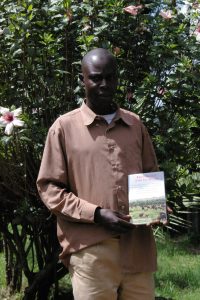One of the favorite parts of my job is serving as a translation consultant to the Kenya Bible Society as it is working to revise the Maasai Bible. The Maa translation was prepared from the English RSV with occasional reference to the Living Bible (English) paraphrase. Now the folks who worked on the original, all things considered, did excellent work. But there are still passages which are incomprehensible to native speakers, clauses that are missing, and other errors.
For over a year I’ve been working with the two Maasai believers who are overseeing this revision via email, together with a missionary friend and colleague of mine (Paul Highfield). But recently I’ve learned that their office is in Ngong town, just 15 minutes from our house. So I’ve started meeting weekly with Peter and Paul. They have Maasai names, of course, but I was introduced to them with their biblical names, and “Peter and Paul” does sound nicely apostolic for bible translation work.
I want to take a moment to share a snapshot of this part of our ministry. At our last meeting Peter asked me to review a particularly tricky passage in Romans. The verses in Maa had been translated in a “literal” and (wooden) word-for-word fashion from the RSV. Consequentially, it made absolutely no sense whatsoever to a Maasai … unless, of course they were also fluent and literate in English and had access to the RSV. Then they could figure out the meaning of the English … but the Maa verses themselves had no discernible meaning. So my “apostolic” colleagues had labored over six or seven English translations and come up with a translation that made sense in Maa. They asked me to review it to see if it made the same sort of sense as the Greek in which Paul (the other one, the famous one) had written it.
So I started reading. But before I got to the revised tricky part of the passage something caught my eye. “Mme ninye,” it said. Literally that means “not he/she/it.” But the sense of the Maa phrase is better rendered in English as “no, not that,” as in “no, I’d rather not have coffee, thank you … could I perhaps have some tea?” But I knew that’s a passage where Paul is saying μη γενοιτο, pronounced “may genoito!”
The phrase is sometimes translated in English versions as “by no means!” or “not at all!” Literally, it means “may it not be!” But it has the moral force of a curse, sort of like saying to your buddy John, “John, may YOU not be, may you not exist now, may you never have existed in the past nor may you come to exist in the future.” This is very strong language. Several times Paul asks a rhetorical question such as “shall we then continue to sin so that grace may abound?” and then, just to make sure that there is no room for mistake, he answers his own question: Absolutely not! Never! God forbid! or even, Hell no! He uses the phrase 10 times in Romans, once in 1 Corinthians and thrice in Galatians. The crowd that Jesus was teaching uses it once, in Luke 20.16.
Clearly to translate may genoito as mme ninye, no, not that, maybe something else is a bit weak. So Peter and I spent over an hour discussing it until we found a Maa phrase that carries the force Paul intended. I noticed that in the Luke passage, the phrase is rendered as “God forbid!” in the RSV rather than the weaker “by no means” in the Romans verses on which we were working. Next I checked the Maa version and was delighted to discover that the original translators had nailed it. They didn’t translate “God forbid!” literally, but they did translate the moral and dynamic force of “God forbid!” So the fourteen times Paul uses the phrase, the new revision of the Maa bible will now read “Taba meing’uang’a!” This phrase is the strongest of “absolutely not, not now, not ever” language that the Maa language has to offer. It’s a perfect fit in Paul’s discourses. Thus to the original translation, we can say “mme ninye!” (not that, something else) and offer a new translation to Maasai believers that better conveys the apostle’s intended sense.
..
.
postscript:
By the way, the rest of the tricky passage was fine. Next we need to check the OT. The Septuagint, the ancient Greek translation of the OT used by the first century Church, uses the may genoito phrase three times. Each time it translates the same Hebrew word, khaliyl (חליל). That word occurs 21 times in the Hebrew OT and is used where ever it says “far be it from” so-and-so to do such-and-such. Now we just need to look at those verses and determine for each case from the context whether in Maa we should have a simple mme ninye, the slightly stronger taba mme ninye, or the full strength taba mme meing’uang’a … .
The goal? A Maa bible that is comprehensible to Maasai believers. … I love my job.
.








